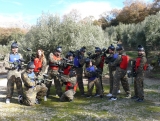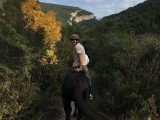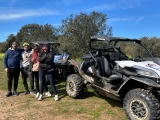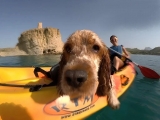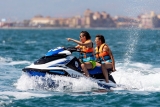The vast majority of scuba diving instructors follow pedagogical principles and understand that each student learns at a different pace. This article provides guidelines for students who require more time, attention and effort. These guidelines are extremely simple... and useful.

A Thousand Questions and Doubts
Someone once felt afraid, just like you, wondering: "What lies beneath our feet? What kind of creatures will I encounter? How will they react? Will I breathe properly underwater? Will I have enough air to complete the dive? Will I feel claustrophobic? And if the wetsuit feels tight on land, will it feel the same underwater?"
Each fear or phobia requires personal attention. Overcoming these limiting thoughts to begin or continue with this thrilling activity is simply a matter of time and practice.
Encountering "Beings and Things" Underwater
Regarding marine life, I assure you that typically we disturb them more than they disturb us. If we avoid touching, feeding, or invading their space, we prevent defensive reactions. They'll usually swim away from "such a noisy, bubbling creature" anyway.
Our intention is to observe underwater life, enjoy ourselves and respect the marine environment. Creatures will simply observe us cautiously. Take diving courses to learn about underwater flora and fauna. Once you know it, you'll be fascinated - loving it far more than fearing it.
First Experiences with Buoyancy
Initially, the wetsuit feels "extremely" tight. We worry it might restrict breathing. False! This sensation is universal for beginners. It can't restrict circulation but needs to be snug to prevent excessive water flow that would rapidly cool our bodies.

Once submerged, we discover the wetsuit requires no effort to maintain buoyancy. When wet, it moulds to your body. Use this moment to relax, breathing slowly and deeply - exhaling completely. Close your eyes and let the water cradle you briefly.
How to Breathe Underwater with Scuba Gear?
Recall how you breathe after physical exertion - perhaps reaching a mountain summit. You take a deep breath of fresh air, hold it momentarily, then release slowly. This is how you should breathe, especially when tired, anxious or afraid.
This instinctive "pleasure mechanism" quickly restores normal breathing cycles (approximately: two-second inhale, one-second hold, three-second exhale).
Repeat this whenever fatigued. Stop, signal your buddy, and regain normal breathing!
Remember - we must avoid panic, that is, "mental block".

Recognising the Path to Panic
The route to panic follows this progression: Fatigue → Anxiety → Fear → Panic
Therefore, the correct response mechanism is: Stop → Breathe → Relax → Think → Act
You'd be amazed how breathing techniques overcome difficulties underwater and above. When someone's distressed, we instinctively say: "Calm down. Breathe deeply and slowly"... There's good reason for this.
Now we can self-manage fears using breathing techniques. Recognising early symptoms, we apply the above method.
Primary Fear Factor: Mask Flooding
Another common concern is mask flooding - seawater contacting eyes and nose.
You'll learn mask-clearing during training, but if still apprehensive, try this basic exercise:
Sit where your feet touch water. Fill your mask, position it horizontally, tilt your head forward. Close eyes, inhale through mouth, exhale through nose - expelling water. Master this before trying eyes-open (slightly uncomfortable but manageable).
Congratulations - mask flooding no longer troubles you.
The Regulator: Breathing "Without Your Nose"
Remember regulator breathing? Pinch your nose - you must "request air" through your mouth. We quickly adapt to this sensation, identical to breathing through the regulator mouthpiece. With tank open at surface, insert mouthpiece, pinch nose and breathe. Notice the sensation? Continue - you'll soon adjust.
Numerous exercises help acclimate mind and body to aquatic environments, progressively reducing fear while increasing self-control.

Let's Dive: Practising Underwater with Your Instructor
Now prepared, don your gear with your buddy's help. Review all underwater signals. Inflate your BCD at surface, breathe through regulator. Try removing your mask while continuing to breathe through the regulator - eyes open, nose flooded. No problem. You're controlling nasal breathing. You're ready to descend. Use the breathing technique described earlier. When comfortable, we'll descend a few metres, kneel on the bottom, and perform relaxation exercises.

Remember - panic can develop quickly. This training teaches necessary techniques to avoid freezing in stressful situations, applying them when needed.
Remember fear is personal and should be treated as such. By understanding its mechanisms, we control it. Don't give up - the key lies in applying methodology suited to individual needs.





